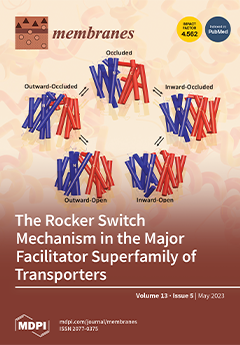In this paper, refined sugar wastewater (RSW) is treated by electrodialysis (ED) coupled with an upflow anaerobic sludge blanket (UASB) and membrane bioreactor (MBR). The salt in RSW was first removed by ED, and then the remaining organic components in RSW were degraded
[...] Read more.
In this paper, refined sugar wastewater (RSW) is treated by electrodialysis (ED) coupled with an upflow anaerobic sludge blanket (UASB) and membrane bioreactor (MBR). The salt in RSW was first removed by ED, and then the remaining organic components in RSW were degraded by a combined UASB and MBR system. In the batch operation of ED, the RSW was desalinated to a certain level (conductivity < 6 mS·cm
−1) at different dilute to concentrated stream volume ratios (V
D/V
C). At the volume ratio of 5:1, the salt migration rate
JR and COD migration rate
JCOD were 283.9 g·h
−1·m
−2 and 13.84 g·h
−1·m
−2, respectively, and the separation factor
α (defined as
JCOD/JR) reached a minimum value of 0.0487. The ion exchange capacity (
IEC) of ion exchange membranes (IEMs) after 5 months of usage showed a slight change from 2.3 mmol·g
−1 to 1.8 mmol·g
−1. After the ED treatment, the effluent from the tank of the dilute stream was introduced into the combined UASB-MBR system. In the stabilization stage, the average COD of UASB effluent was 2048 mg·L
−1, and the effluent COD of MBR was maintained below 44–69 mg·L
−1, which met the discharge standard of water contaminants for the sugar industry. The coupled method reported here provides a viable idea and an effective reference for treating RSW and other similar industrial wastewaters with high salinity and organic contents.
Full article






